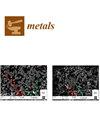用 DRECE 法成型的低碳钢经热浸锌镀锌和电位极化测试研究其腐蚀行为
IF 2.5
3区 材料科学
Q3 MATERIALS SCIENCE, MULTIDISCIPLINARY
引用次数: 0
摘要
由于硅含量极低的低碳非合金钢易于操作,因此在结构钢和汽车应用中得到广泛使用。通过严重塑性变形(SPD)技术,这种钢的机械性能可以得到显著提高。我们的研究重点是双轧制等道挤压(DRECE)方法的实际优势,这种方法可以增强钢的强度,并对材料硬度和后续热浸镀锌的厚度产生影响。此外,还研究了钢材的腐蚀电位和电流与材料硬度和厚度的函数关系。研究结果表明,在成型机第一次运行后,硬度 HV 30 提高了 20%,第二次运行后又提高了 10%。随后的镀锌可使 HV 30 值进一步提高 1-12%。值得注意的是,DRECE 淬火对腐蚀电位和电流没有明显的统计学影响;但镀锌的影响与预期相同。本文章由计算机程序翻译,如有差异,请以英文原文为准。
Low-Carbon Steel Formed by DRECE Method with Hot-Dip Zinc Galvanizing and Potentiodynamic Polarization Tests to Study Its Corrosion Behavior
The use of low-carbon unalloyed steel with minimal silicon content is widespread in structural steel and automotive applications due to its ease of manipulation. The mechanical properties of this steel can be significantly enhanced through severe plastic deformation (SPD) techniques. Our study focuses on the practical benefits of the dual rolling equal channel extrusion (DRECE) method, which strengthens the steel and has implications for material hardness and the thickness of subsequently applied hot-dip zinc galvanizing. Furthermore, the steel’s corrosion potential and current are investigated as a function of material hardness and thickness. The findings show a 20% increase in hardness HV 30 after the first run through the forming machine, with an additional 10% increase after the second run. Subsequent galvanizing leads to a further 1–12% increase in HV 30 value. Notably, the DRECE hardening demonstrates no statistically significant effect on the corrosion potential and current; however, the impact of galvanizing is as anticipated.
求助全文
通过发布文献求助,成功后即可免费获取论文全文。
去求助
来源期刊

Metals
MATERIALS SCIENCE, MULTIDISCIPLINARY-METALLURGY & METALLURGICAL ENGINEERING
CiteScore
4.90
自引率
13.80%
发文量
1832
审稿时长
1.5 months
期刊介绍:
Metals (ISSN 2075-4701) is an open access journal of related scientific research and technology development. It publishes reviews, regular research papers (articles) and short communications. Our aim is to encourage scientists to publish their experimental and theoretical results in as much detail as possible. Therefore, there is no restriction on the length of the papers. The full experimental details must be provided so that the results can be reproduced. Metals provides a forum for publishing papers which advance the in-depth understanding of the relationship between the structure, the properties or the functions of all kinds of metals.
 求助内容:
求助内容: 应助结果提醒方式:
应助结果提醒方式:


